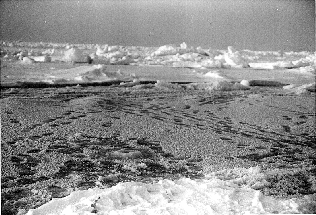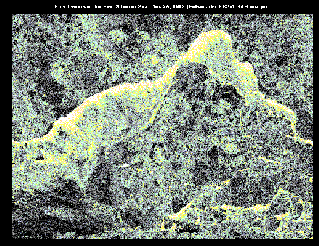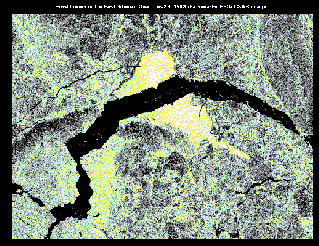Frost Flowers
 Frost Flowers in the Beaufort Sea (315KB GIF)
Frost Flowers in the Beaufort Sea (315KB GIF)
Frost flowers are highly saline ice crystals which grow on the surface of new ice. These structures have been observed all over the Arctic but until recently were regarded only as a curiosity. Recently, however, frost flowers have attracted attention because of their effect on high resolution remote sensing instruments such as SAR and AVHRR. Our research shows that frost flowers both increase the radar backscattering and decrease the radiometric surface temperature of new sea ice.
The following images were produced from data acquired by the Synthetic Aperature Radar (SAR) instrument aboard the European Space Agency's ERS-1 satellite in December of 1993. They show scenes of sea ice near the New Siberian Islands in shallow seas north of Siberia. The images, which have been enhanced by false-coloring, show some interesting areas of new ice growth, and demonstrate the dramatic appearance of frost flowers in SAR imagery. The horizontal scale of these images is approximately 20 km.
 Satellite image (159KB GIF)
Satellite image (159KB GIF)
False-color ERS-1 SAR image of the ice pack in the East Siberian Sea, acquired on Christmas Day, 1993. The band running horizontally across the image is an area of new ice which has formed in a lead. The bright white areas along the top of the band are probably caused by frost flowers.
 Satellite image (145 KB GIF)
Satellite image (145 KB GIF)
This image was taken three days later, on December 28. The black crescent-shaped area is a new lead which has opened across the old lead. The outline of the older lead can be seen, but the bright areas have moved. This may be due to frost flowers being covered by drifting snow in one area, and new frost flowers appearing, possibly enhanced by moisture from the new lead.
SAR images copyright European Space Agency, 1993
Lab experiments
Back to Polar Oceanography Home Page
 Satellite image (159KB GIF)
Satellite image (159KB GIF) Frost Flowers in the Beaufort Sea (315KB GIF)
Frost Flowers in the Beaufort Sea (315KB GIF)  Satellite image (145 KB GIF)
Satellite image (145 KB GIF)